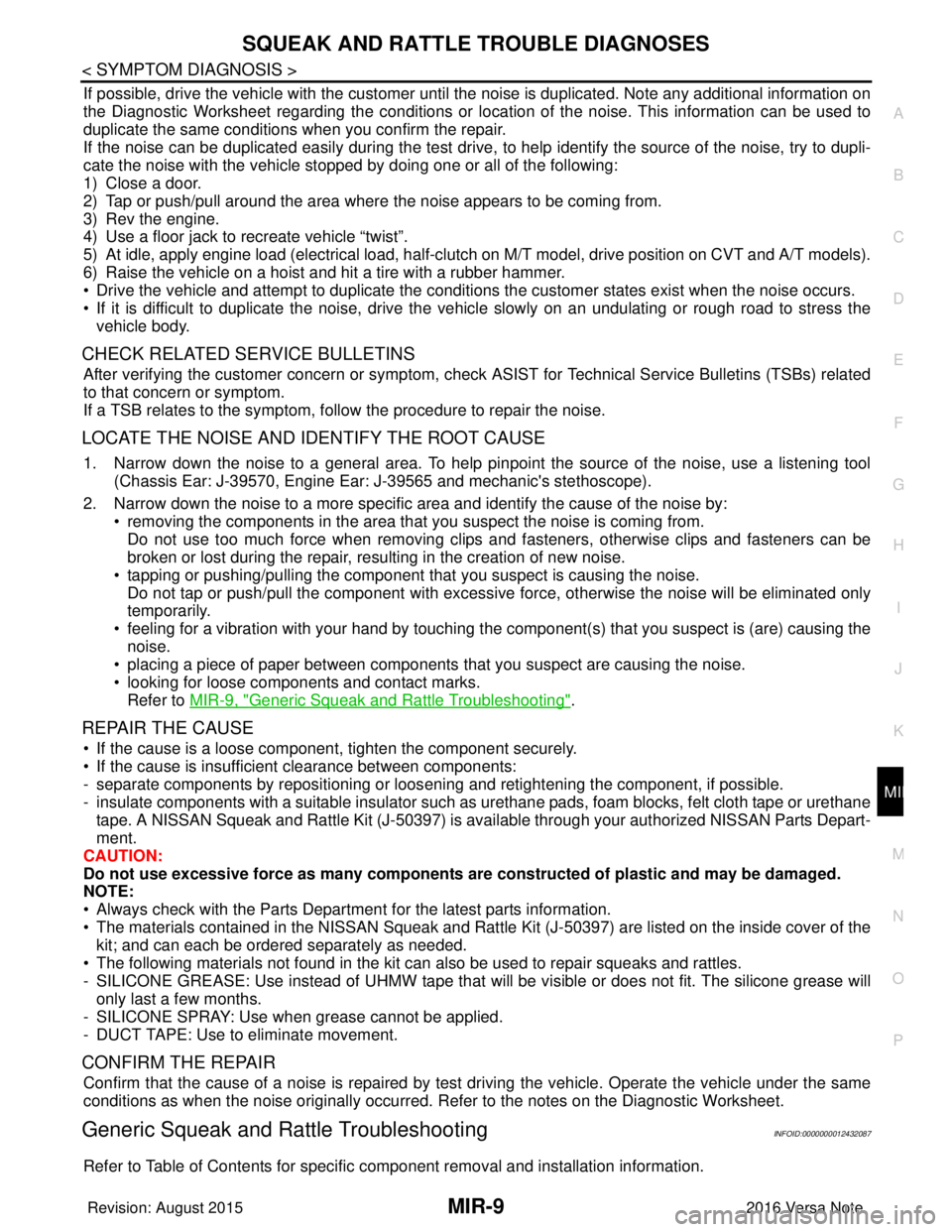2016 NISSAN NOTE engine
[x] Cancel search: enginePage 2483 of 3641

SQUEAK AND RATTLE TROUBLE DIAGNOSESMIR-9
< SYMPTOM DIAGNOSIS >
C
DE
F
G H
I
J
K
M A
B
MIR
N
O P
If possible, drive the vehicle with the customer until the noise is duplicated. Note any additional information on
the Diagnostic Worksheet regarding the conditions or lo cation of the noise. This information can be used to
duplicate the same conditions when you confirm the repair.
If the noise can be duplicated easily during the test drive, to help identify the source of the noise, try to dupli-
cate the noise with the vehicle stopped by doing one or all of the following:
1) Close a door.
2) Tap or push/pull around the area where the noise appears to be coming from.
3) Rev the engine.
4) Use a floor jack to recreate vehicle “twist”.
5) At idle, apply engine load (electrical load, half-clutch on M/T model, drive position on CVT and A/T models).
6) Raise the vehicle on a hoist and hit a tire with a rubber hammer.
• Drive the vehicle and attempt to duplicate the conditions the customer states exist when the noise occurs.
• If it is difficult to duplicate the noise, drive the vehicle slowly on an undulating or rough road to stress the
vehicle body.
CHECK RELATED SERVICE BULLETINS
After verifying the customer concern or symptom, check ASIST for Technical Service Bulletins (TSBs) related
to that concern or symptom.
If a TSB relates to the symptom, follow the procedure to repair the noise.
LOCATE THE NOISE AND IDENTIFY THE ROOT CAUSE
1. Narrow down the noise to a general area. To help pinpoint the source of the noise, use a listening tool (Chassis Ear: J-39570, Engine Ear: J-39565 and mechanic's stethoscope).
2. Narrow down the noise to a more specific area and identify the cause of the noise by: • removing the components in the area that you suspect the noise is coming from.Do not use too much force when removing clips and fasteners, otherwise clips and fasteners can be
broken or lost during the repair, resulting in the creation of new noise.
• tapping or pushing/pulling the component that you suspect is causing the noise.
Do not tap or push/pull the component with excessive force, otherwise the noise will be eliminated only
temporarily.
• feeling for a vibration with your hand by touching the component(s) that you suspect is (are) causing the
noise.
• placing a piece of paper between components that you suspect are causing the noise.
• looking for loose components and contact marks. Refer to MIR-9, "
Generic Squeak and Rattle Troubleshooting".
REPAIR THE CAUSE
• If the cause is a loose component, tighten the component securely.
• If the cause is insufficient clearance between components:
- separate components by repositioning or loos ening and retightening the component, if possible.
- insulate components with a suitable insulator such as urethane pads, foam blocks, felt cloth tape or urethane tape. A NISSAN Squeak and Rattle Kit (J-50397) is available through your authorized NISSAN Parts Depart-
ment.
CAUTION:
Do not use excessive force as many components are constructed of plastic and may be damaged.
NOTE:
• Always check with the Parts Department for the latest parts information.
• The materials contained in the NISSAN Squeak and Rattle Kit (J-50397) are listed on the inside cover of the
kit; and can each be ordered separately as needed.
• The following materials not found in the kit can also be used to repair squeaks and rattles.
- SILICONE GREASE: Use instead of UHMW tape that will be visible or does not fit. The silicone grease will
only last a few months.
- SILICONE SPRAY: Use when grease cannot be applied.
- DUCT TAPE: Use to eliminate movement.
CONFIRM THE REPAIR
Confirm that the cause of a noise is repaired by test driving the vehicle. Operate the vehicle under the same
conditions as when the noise originally occurred. Refer to the notes on the Diagnostic Worksheet.
Generic Squeak and Rattle TroubleshootingINFOID:0000000012432087
Refer to Table of Contents for specific component removal and installation information.
Revision: August 2015 2016 Versa Note
cardiagn.com
Page 2485 of 3641

SQUEAK AND RATTLE TROUBLE DIAGNOSESMIR-11
< SYMPTOM DIAGNOSIS >
C
DE
F
G H
I
J
K
M A
B
MIR
N
O P
1. Loose harness or harness connectors.
2. Front console map/reading lamp lens loose.
3. Loose screws at console attachment points.
SEATS
When isolating seat noise it's important to note the position the seat is in and the load placed on the seat when
the noise is present. These conditions should be duplicated when verifying and isolating the cause of the
noise.
Cause of seat noise include:
1. Headrest rods and holder
2. A squeak between the seat pad cushion and frame
3. The rear seatback lock and bracket
These noises can be isolated by moving or pressing on the suspected components while duplicating the con-
ditions under which the noise occurs. Most of thes e incidents can be repaired by repositioning the component
or applying urethane tape to the contact area.
UNDERHOOD
Some interior noise may be caused by components under the hood or on the engine wall. The noise is then
transmitted into the passenger compartment.
Causes of transmitted underhood noise include:
1. Any component installed to the engine wall
2. Components that pass through the engine wall
3. Engine wall mounts and connectors
4. Loose radiator installation pins
5. Hood bumpers out of adjustment
6. Hood striker out of adjustment
These noises can be difficult to isolate since they cannot be reached from the interior of the vehicle. The best
method is to secure, move or insulate one component at a time and test drive the vehicle. Also, engine rpm or
load can be changed to isolate the noise. Repairs can usually be made by moving, adjusting, securing, or
insulating the component causing the noise.
Revision: August 2015 2016 Versa Note
cardiagn.com
Page 2495 of 3641

PB-2
< PRECAUTION >
PRECAUTIONS
PRECAUTION
PRECAUTIONS
Precaution for Supplemental Restraint System (SRS) "AIR BAG" and "SEAT BELT
PRE-TENSIONER"
INFOID:0000000012430686
The Supplemental Restraint System such as “A IR BAG” and “SEAT BELT PRE-TENSIONER”, used along
with a front seat belt, helps to reduce the risk or severity of injury to the driver and front passenger for certain
types of collision. Information necessary to service the system safely is included in the SR and SB section of
this Service Manual.
WARNING:
• To avoid rendering the SRS inopera tive, which could increase the risk of personal injury or death in
the event of a collision which would result in air bag inflation, all maintenance must be performed by
an authorized NISSAN/INFINITI dealer.
• Improper maintenance, including in correct removal and installation of the SRS, can lead to personal
injury caused by unintent ional activation of the system. For re moval of Spiral Cable and Air Bag
Module, see the SR section.
• Do not use electrical test equipmen t on any circuit related to the SRS unless instructed to in this
Service Manual. SRS wiring harn esses can be identified by yellow and/or orange harnesses or har-
ness connectors.
PRECAUTIONS WHEN USING POWER TOOLS (AIR OR ELECTRIC) AND HAMMERS
WARNING:
• When working near the Airbag Diagnosis Sensor Unit or other Airbag System sensors with the Igni-
tion ON or engine running, DO NOT use air or electri c power tools or strike near the sensor(s) with a
hammer. Heavy vibration could activate the sensor( s) and deploy the air bag(s), possibly causing
serious injury.
• When using air or electric power tools or hammers , always switch the Ignition OFF, disconnect the
battery and wait at least three minutes before performing any service.
Revision: August 2015 2016 Versa Note
cardiagn.com
Page 2504 of 3641

PCS
PCS-1
ELECTRICAL & POWER CONTROL
C
DE
F
G H
I
J
K L
B
SECTION PCS
A
O P
N
CONTENTS
POWER CONTROL SYSTEM
IPDM E/R
PRECAUTION ....... ........................................
3
PRECAUTIONS .............................................. .....3
Precaution for Supplemental Restraint System
(SRS) "AIR BAG" and "SEAT BELT PRE-TEN-
SIONER" ............................................................. ......
3
SYSTEM DESCRIPTION ..............................4
COMPONENT PARTS ................................... .....4
Component Parts Location .................................. ......4
SYSTEM ..............................................................5
RELAY CONTROL SYSTEM ................................ ......5
RELAY CONTROL SYSTEM : System Descrip-
tion ...................................................................... ......
5
RELAY CONTROL SYSTEM : Fail-safe ...................6
POWER CONSUMPTION CONTROL SYSTEM ... ......7
POWER CONSUMPTION CONTROL SYSTEM :
System Description ...................................................
8
DIAGNOSIS SYSTEM (IPDM E/R) ......................9
Diagnosis Description ......................................... ......9
CONSULT Function (IPDM E/R) .............................10
ECU DIAGNOSIS INFORMATION ..............13
IPDM E/R (INTELLIGENT POWER DISTRI-
BUTION MODULE ENGINE ROOM) ............. ....
13
Reference Value ................................................. ....13
Fail-safe ..................................................................19
DTC Index ..............................................................20
WIRING DIAGRAM ......................................21
IPDM E/R (INTELLIGENT POWER DISTRI-
BUTION MODULE ENGINE ROOM) ............. ....
21
Wiring Diagram ................................................... ....21
DTC/CIRCUIT DIAGNOSIS .........................26
U1000 CAN COMM CIRCUIT ...........................26
Description ........................................................... ....26
DTC Logic ................................................................26
Diagnosis Procedure ...............................................26
B2098 IGNITION RELAY ON STUCK ..............27
DTC Logic ................................................................27
Diagnosis Procedure ...............................................27
B2099 IGNITION RELAY OFF STUCK ............28
DTC Logic ................................................................28
Diagnosis Procedure ...............................................28
POWER SUPPLY AND GROUND CIRCUIT ....29
Diagnosis Procedure ...............................................29
REMOVAL AND INSTALLATION ...............30
IPDM E/R ...........................................................30
Exploded View ..................................................... ....30
Removal and Installation .........................................30
POWER DISTRIBUTION SYSTEM
PRECAUTION ...... ........................................
32
PRECAUTIONS .................................................32
Precaution for Supplemental Restraint System
(SRS) "AIR BAG" and "SEAT BELT PRE-TEN-
SIONER" ............................................................. ....
32
SYSTEM DESCRIPTION .............................33
COMPONENT PARTS ......................................33
Component Parts Location .................................. ....33
SYSTEM ............................................................34
POWER DISTRIBUTION SYSTEM ........................ ....34
POWER DISTRIBUTION SYSTEM : System De-
scription ............................................................... ....
34
Fail-safe ...................................................................35
Revision: August 2015 2016 Versa Note
cardiagn.com
Page 2505 of 3641

PCS-2
DIAGNOSIS SYSTEM (BCM) ............................37
COMMON ITEM ..................................................... ...37
COMMON ITEM : CONSULT Function (BCM -
COMMON ITEM) ....................................................
37
INTELLIGENT KEY ................................................ ...38
INTELLIGENT KEY : CONSULT Function (BCM -
INTELLIGENT KEY) ...............................................
38
ECU DIAGNOSIS INFORMATION ........... ...41
BCM, IPDM E/R .............................................. ...41
List of ECU Reference ......................................... ...41
WIRING DIAGRAM .....................................42
POWER DISTRIBUTION SYSTEM ................ ...42
Wiring Diagram .................................................... ...42
BASIC INSPECTION ...................................50
DIAGNOSIS AND REPAIR WORK FLOW ..... ...50
Work Flow ............................................................ ...50
PROCEDURE FOR TEMPORARILY DIS-
ABLING THE IGNITION BATTERY SAVER
SYSTEM .......................................................... ...
53
Description ........................................................... ...53
Work Procedure ......................................................53
DTC/CIRCUIT DIAGNOSIS ...................... ...54
U1000 CAN COMM CIRCUIT ......................... ...54
Description ........................................................... ...54
DTC Logic ...............................................................54
Diagnosis Procedure ..............................................54
U1010 CONTROL UNIT (CAN) .........................55
DTC Logic ............................................................ ...55
Diagnosis Procedure ..............................................55
B2614 ACC RELAY CIRCUIT ...........................56
DTC Logic ............................................................ ...56
Diagnosis Procedure ..............................................56
B2615 BLOWER RELAY CIRCUIT ...................58
DTC Logic ............................................................ ...58
Diagnosis Procedure ..............................................58
B2616 IGNITION RELAY CIRCUIT ...................60
DTC Logic ............................................................ ...60
Diagnosis Procedure ............................................ ...60
B2618 BCM .......................................................62
DTC Logic ............................................................ ...62
Diagnosis Procedure ...............................................62
B261A PUSH-BUTTON IGNITION SWITCH .....63
DTC Logic ............................................................ ...63
Diagnosis Procedure ...............................................63
B26F1 IGNITION RELAY ..................................65
DTC Logic ...............................................................65
Diagnosis Procedure ...............................................65
B26F2 IGNITION RELAY ..................................66
DTC Logic ...............................................................66
Diagnosis Procedure ...............................................66
B26F6 BCM .......................................................68
DTC Logic ............................................................ ...68
Diagnosis Procedure ...............................................68
PUSH-BUTTON IGNITION SWITCH .................70
Component Function Check ............................... ...70
Diagnosis Procedure ...............................................70
Component Inspection ............................................71
POWER SUPPLY AND GROUND CIRCUIT .....73
BCM ........................................................................ ...73
BCM : Diagnosis Procedure ....................................73
IPDM E/R (INTELLIGENT POWER DISTRIBU-
TION MODULE ENGINE ROOM) ........................... ...
73
IPDM E/R (INTELLIGENT POWER DISTRIBU-
TION MODULE ENGINE ROOM) : Diagnosis Pro-
cedure .....................................................................
73
SYMPTOM DIAGNOSIS ............................75
PUSH-BUTTON IGNITION SWITCH DOES
NOT OPERATE .............................................. ...
75
Description ........................................................... ...75
Diagnosis Procedure ...............................................75
REMOVAL AND INSTALLATION ..............76
BCM (BODY CONTROL MODULE) ............... ...76
Removal and Installation .........................................76
PUSH-BUTTON IGNITION SWITCH .............. ...77
Removal and Installation .........................................77
Revision: August 2015 2016 Versa Note
cardiagn.com
Page 2506 of 3641
![NISSAN NOTE 2016 Service Repair Manual PCS
PRECAUTIONSPCS-3
< PRECAUTION > [IPDM E/R]
C
D
E
F
G H
I
J
K L
B A
O P
N
PRECAUTION
PRECAUTIONS
Precaution for Supplemental
Restraint System (SRS) "AIR BAG" and "SEAT BELT
PRE-TENSIONER"
INFOID: NISSAN NOTE 2016 Service Repair Manual PCS
PRECAUTIONSPCS-3
< PRECAUTION > [IPDM E/R]
C
D
E
F
G H
I
J
K L
B A
O P
N
PRECAUTION
PRECAUTIONS
Precaution for Supplemental
Restraint System (SRS) "AIR BAG" and "SEAT BELT
PRE-TENSIONER"
INFOID:](/manual-img/5/57363/w960_57363-2505.png)
PCS
PRECAUTIONSPCS-3
< PRECAUTION > [IPDM E/R]
C
D
E
F
G H
I
J
K L
B A
O P
N
PRECAUTION
PRECAUTIONS
Precaution for Supplemental
Restraint System (SRS) "AIR BAG" and "SEAT BELT
PRE-TENSIONER"
INFOID:0000000012433266
The Supplemental Restraint System such as “AIR BAG” and “SEAT BELT PRE-TENSIONER”, used along
with a front seat belt, helps to reduce the risk or severi ty of injury to the driver and front passenger for certain
types of collision. Information necessary to service the system safely is included in the SR and SB section of
this Service Manual.
WARNING:
• To avoid rendering the SRS inoper ative, which could increase the risk of personal injury or death in
the event of a collision which would result in air bag inflation, all maintenance must be performed by
an authorized NISSAN/INFINITI dealer.
• Improper maintenance, including in correct removal and installation of the SRS, can lead to personal
injury caused by unintentional act ivation of the system. For removal of Spiral Cable and Air Bag
Module, see the SR section.
• Do not use electrical test equipm ent on any circuit related to the SRS unless instructed to in this
Service Manual. SRS wiring harnesses can be identi fied by yellow and/or orange harnesses or har-
ness connectors.
PRECAUTIONS WHEN USING POWER TOOLS (AIR OR ELECTRIC) AND HAMMERS
WARNING:
• When working near the Airbag Diagnosis Sensor Un it or other Airbag System sensors with the Igni-
tion ON or engine running, DO NOT use air or el ectric power tools or strike near the sensor(s) with a
hammer. Heavy vibration could activate the sensor( s) and deploy the air bag(s), possibly causing
serious injury.
• When using air or electric power tools or hammers, always switch the Ignition OFF, disconnect the
battery and wait at least three mi nutes before performing any service.
Revision: August 2015 2016 Versa Note
cardiagn.com
Page 2507 of 3641
![NISSAN NOTE 2016 Service Repair Manual PCS-4
< SYSTEM DESCRIPTION >[IPDM E/R]
COMPONENT PARTS
SYSTEM DESCRIPTION
COMPONENT PARTS
Component Parts LocationINFOID:0000000012433267
1. IPDM E/R
A. Engine compartment (LH)
AWMIA1435ZZ
Revision: A NISSAN NOTE 2016 Service Repair Manual PCS-4
< SYSTEM DESCRIPTION >[IPDM E/R]
COMPONENT PARTS
SYSTEM DESCRIPTION
COMPONENT PARTS
Component Parts LocationINFOID:0000000012433267
1. IPDM E/R
A. Engine compartment (LH)
AWMIA1435ZZ
Revision: A](/manual-img/5/57363/w960_57363-2506.png)
PCS-4
< SYSTEM DESCRIPTION >[IPDM E/R]
COMPONENT PARTS
SYSTEM DESCRIPTION
COMPONENT PARTS
Component Parts LocationINFOID:0000000012433267
1. IPDM E/R
A. Engine compartment (LH)
AWMIA1435ZZ
Revision: August 2015
2016 Versa Note
cardiagn.com
Page 2516 of 3641
![NISSAN NOTE 2016 Service Repair Manual PCS
IPDM E/R (INTELLIGENT POWER DISTRIBUTION MODULE ENGINE ROOM)
PCS-13
< ECU DIAGNOSIS INFORMATION > [IPDM E/R]
C
D
E
F
G H
I
J
K L
B A
O P
N
ECU DIAGNOSIS INFORMATION
IPDM E/R (INTELLIGENT POWER
DI NISSAN NOTE 2016 Service Repair Manual PCS
IPDM E/R (INTELLIGENT POWER DISTRIBUTION MODULE ENGINE ROOM)
PCS-13
< ECU DIAGNOSIS INFORMATION > [IPDM E/R]
C
D
E
F
G H
I
J
K L
B A
O P
N
ECU DIAGNOSIS INFORMATION
IPDM E/R (INTELLIGENT POWER
DI](/manual-img/5/57363/w960_57363-2515.png)
PCS
IPDM E/R (INTELLIGENT POWER DISTRIBUTION MODULE ENGINE ROOM)
PCS-13
< ECU DIAGNOSIS INFORMATION > [IPDM E/R]
C
D
E
F
G H
I
J
K L
B A
O P
N
ECU DIAGNOSIS INFORMATION
IPDM E/R (INTELLIGENT POWER
DISTRIBUTION MODULE ENGINE
ROOM)
Reference ValueINFOID:0000000012433273
VALUES ON THE DIAGNOSIS TOOL
Monitor Item ConditionValue/Status
MOTOR FAN REQ Engine idle speed Changes depending on engine cool-
ant temperature, air conditioner op-
eration status, vehicle speed, etc.
1/2/3/4
AC COMP REQ Engine running A/C switch OFF
Off
A/C switch ON
(Compressor is operating) On
TAIL&CLR REQ Lighting switch OFF
Off
Lighting switch 1ST or 2ND On
HL LO REQ Lighting switch OFF
Off
Lighting switch 2ND On
HL HI REQ Lighting switch 2ND Lighting switch other than HI and
PA S S
Off
Lighting switch HI or PASS On
FR FOG REQ Lighting switch 2ND Front fog lamp switch OFF
Off
Front fog lamp switch ON On
FR WIP REQ Ignition switch ON Front wiper switch OFF
Stop
Front wiper switch INT 1LOW
Front wiper switch LO Low
Front wiper switch HI Hi
WIP AUTO STOP Ignition switch ON Front wiper stop position
STOP P
Any position other than front wiper
stop position ACT P
WIP PROT Ignition switch ON Front wiper operates normally.
Off
Front wiper stops at fail-safe opera-
tion. BLOCK
IGN RLY1 -REQ Ignition switch OFF or ACC
Off
Ignition switch ON On
IGN RLY Ignition switch OFF or ACC
Off
Ignition switch ON On
PUSH SW Release the push-button ignition switch
Off
Press the push-button ignition switch On
INTER/NP SW Ignition switch ON Selector lever in any position other
than P or N (CVT models)
Off
Release clutch pedal (M/T models)
Selector lever in P or N position
(CVT models) On
Depress clutch pedal (M/T models)
ST RLY CONT Ignition switch ON
Off
At engine cranking On
Revision: August 2015 2016 Versa Note
cardiagn.com